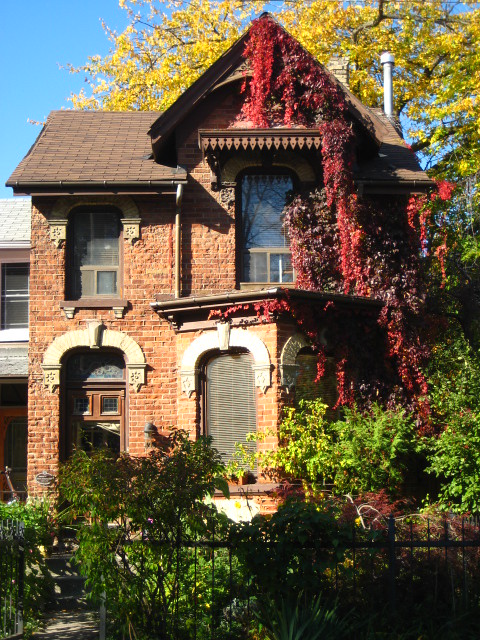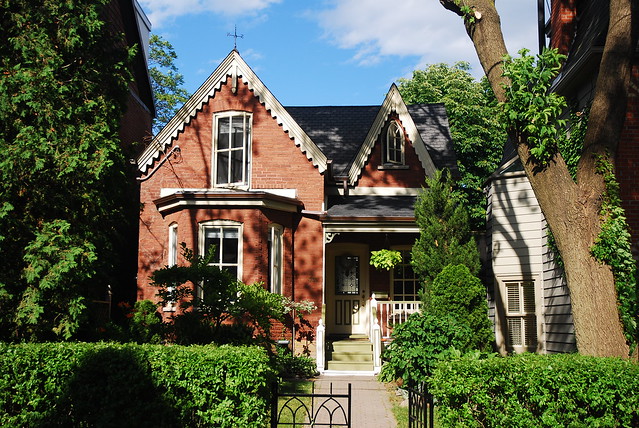It was not too long ago that Cabbagetown was the kind of area where families scrimped and saved in order to leave. As with many urban renewal areas in North America, the government demolished much of the old neighborhood to make way for public housing, which at first appeared to be successful but in a few short years started to deteriorate. It was around the same time, the 1970's, that young middle-class professionals and bohemians started to buy old historical properties for mere thousands. In a few short years, a well-restored home could sell for double or triple its original value. Luckily, this new wave of residents protested further demolition of the neighborhood, thus preventing the northward expansion of the public housing. Thanks to them, Toronto didn't lose one of its most charming neighborhoods.
The area today known as Cabbagetown is actually a bit north from the original Cabbagetown. The name apparently derives from the poor 19th century Irish immigrants who grew cabbages in their front yards. The neighborhood is split into two parts, Cabbagetown and South Cabbagetown, both of which I am featuring as to me they are practically one and the same. This is a neighborhood with a great deal of character, heavily wooded yet still retaining an urban density. I'm not sure if it's as bohemian as it once was, but it certainly has a unique identity in Toronto. Cabbagetown is one of those neighborhoods where residents have front garden beauty competitions. It has white picket fences. It has a community feel. In many ways it's the stereotypical perfect place to live, and there's a great deal of pride among homeowners. Many homes even fly the neighborhood flag, similar to the Canadian flag but green with a cabbage instead of the maple leaf.
There are many variations of home styles in Cabbagetown. It has always been a mixed income neighborhood, evidenced by the many large and small homes. From one story cottages to large detached homes, there's an abundance of 19th and early 20th century homes. I think it's a beautiful neighborhood, benefiting greatly from the amount of greenery along its streets. The amount of trees and other plants along the road is quite astonishing given the high housing density. Evidence of the area's past is also interesting to see. The many corner homes which were once shops or pubs, for example.
Useful links:
 |
| Strong preservation laws ensure that even a clash of styles is complimentary as here on Seaton Street |
 |
| The yellow brick of these homes is unique in the neighborhood |

 |
| From above it's easy to see why Cabbagetown is thought to have a village feel. It's mercifully been spared modern development |
 |
| It's delightful how the homes in Cabbagetown reveal themselves behind the trees |
 |
| This elegant row was built in 1889 |
 |
| One of the largest homes in the neighborhood, this 1893 Victorian is currently on the market for $4.9 million |
 |
| The more industrial aesthetic of these homes fits right in |
 |
| Bowman is a short little street just off Carlton with a diverse mix of architectural styles |
 |
| Geneva Avenue on the eastern edge of the neighborhood doesn't have any grand houses but is charming nonetheless |
 |
| Homes on Geneva are among the most affordable at around $600,000 |
 |
| The vines on this Victorian combined with the composition of the front gardens is simply beautiful. It was a wow moment for my father, who never really enjoyed living in Toronto |
 |
| One of the oldest homes in the neighborhood, this eccentric Victorian was built in 1866. It recently sold for $1 million |
 |
| The home on the left here on Sackville Street was recently on the market for $850,000 |
 |
| These steep gables are particularly unique and not often found outside of Toronto. The Victorians designed to extremes |
 |
| Residents go to great lengths to differentiate their gardens. Nearly every home's garden has its own identity |
 |
| Even with large, almost suburban scaled front gardens, the attention to detail ensures it never feels anything but intimate, social, and human-scaled. The iron railings throughout the neighborhood likewise bind the community |
 |
| This beautifully restored row of Victorian cottages was built in 1873 |
 |
| Once home to poor immigrants, there are many such small Victorian cottages throughout Cabbagetown, testament to the neighborhood's humble beginnings. This example is especially endearing |
 |
| I've rarely seen former shops converted to homes as well as those in Cabbagetown |
 |
| Not long ago this home on Amelia Street received an award from the neighborhood association for its garden. The home recently sold for $1.1 million, a price no doubt boosted by the white picket fence |
 |
| Alpha Avenue is an off-the-grid pocket of small cottages |
 |
| Wellesley Avenue, a cul-de-sac, has a quiet village like feel |
 |
| The eastern side of Wellesley Street has a few more contemporary homes but they don't look out of place among the Victorians |
I've often said the main purpose of my blog is to showcase the best examples of urban streetscapes, a purpose for which I can think of few better examples than Cabbagetown. Unlike many other urban neighborhoods, there are no unsightly eyesores which I have had to conveniently ignore. Nearly every home is a national treasure and treated with the care and attention that such homes deserve. It is easy to see why it is often called the best preserved Victorian neighborhood in North America. Some say it is as if stepping back in time 100 years. But actually, I think it is one of those rare cases which actually betters its past form. Looking at old photos of Cabbagetown, the streets are certainly nice and well-maintained but it is clear it is not a particularly wealthy neighborhood and the gardens are nowhere near as nice as they are today.
 |
| Sackville Street in 1936. Image : City of Toronto Archives |
What a difference the years have made. Pre-war Cabbagetown is hardly recognizable as the neighborhood it has become. A little restoration and a lot of greenery goes a long way, and it is very heartening to see. Throughout Toronto and other North American cities there are many neighborhoods which still look quite similar to the image above. Should they be lucky enough to rebound as much as Cabbagetown, great swaths of cities would come back to life. The greenery is key!
The Cabbagetown Preservation Association deserves much of the credit for the neighborhood's revitalization and continued harmony. Most impressive is their dedication to a complete restoration of the entire neighborhood. Rather than relying solely on private work completed by the wealthier homeowners, the association provides grants for lower income residents to fix up homes which otherwise they could never afford. The social benefits of this are profound, ensuring that none of the residents feels second class and creating a stronger community spirit.
It is such a shame large portions of the neighborhood were replaced by substandard public housing, which in years past has resulted in drugs and prostitution in commercial areas of Cabbagetown such as Parliament Street. Apparently it has gotten much better in recent years, however, and general crime is also down though still higher than suburban areas. It is perhaps not surprising then that the neighborhood has less families than average, which I think is a real shame as it has all the elements of a perfect family-friendly place. The strong community links are just the tip of the iceberg. There's also Riverdale Park just east of the neighborhood, a large green space with ample opportunity to play. Across a pedestrian footbridge over Don Valley Parkway, the other half of the park has a soccer field, running track, and tennis courts. Cabbagetown also has Riverdale Farm, once a zoo but today full of farm animals and host to a weekly farmer's market. The neighborhood also has a few schools. It's hard to see why anyone wouldn't want to raise their kids here. Of course, the average household income of over $120,000 may explain the lower amount of kids, as wealthy professionals have less children.
If Jane Jacobs had moved to Toronto ten years later then she did, I think she would have chosen Cabbagetown instead of The Annex. At that time the neighborhood was finally on the up after many years on the brink, but the efforts of numerous protesting residents ensured the survival of this most historical of neighborhoods.
I hope you've enjoyed this look at Cabbagetown. A few more photos below:
A Snow Day in Cabbagetown
First Snow























































































